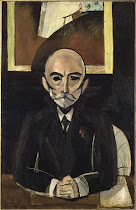The television station put a call out for drawings and paintings by any survivor of the atomic bombing of Hiroshima and Nagasaki. Survivors are known as hibakusha. I think this is the most effective collection of a people's history that I have seen. I am affected by the simplistic translations of the text, the varying quality of the artwork, and knowing that people can still vividly recall these images. Of all the images that I have seen I've noticed the following traumatic images recur frequently: dead children, insects in wounds, melted skin dripping off of fingers, and dead bodies in water (cisterns and rivers) from people trying to cool down.
Mother unable to save her child trapped under the building
 If she were alive now, she would be a woman of 35 or 36. “Hiroko, don't give up, be strong. Namu Amida Butsu, Namu Amida Butsu.” Hiroko... Only her head stuck out from under the fallen ceiling. A girl of 5 or 6.
If she were alive now, she would be a woman of 35 or 36. “Hiroko, don't give up, be strong. Namu Amida Butsu, Namu Amida Butsu.” Hiroko... Only her head stuck out from under the fallen ceiling. A girl of 5 or 6.Shigeru Miyoshi
(40 at time of bombing, 70 at time of drawing)
Two little girls fanned their seriously wounded mother
 Two little girls, one about five and the other about three fanned their seriously wounded mother.
Two little girls, one about five and the other about three fanned their seriously wounded mother.Hiroshi Shindo (33 at time of bombing, 64 at time of drawing)
How old should a child be before they are shown these images? They would undoubtedly be traumatic before they developed the adult ability to desensitize. Worthy trauma? When I was a child I remember Sadako and the Thousand Paper Cranes being read to us. I knew Sadako had died in the hospital and that pushed history further away, the past was another world. Does remembering help? Some Japanese don't want to reveal that they are hibakusha for fear of discrimination or misunderstanding.
 The Hiroshima Peace Memorial Museum, bless their utopian souls, are a tragic bunch. They collect memories with a goal: to prevent this from happening again. A realist can barely resist telling them that their paper cranes, labyrinthine website, and declarations will not stop future nuclear wars. Still, they collect and preserve. A book was published that contained a series of hibakusha artwork. It's called "Unforgettable Fire: Pictures Drawn by Atomic Bomb Survivors". I'm trying to find a copy of the book but I was shocked to find Chapters/Indigo doesn't sell it, my city's library system doesn't have it, and Toronto's massive web of libraries has one copy that you have to request to look at (but it must stay in the library). It looks like I'm going to make my first Amazon.com purchase.
The Hiroshima Peace Memorial Museum, bless their utopian souls, are a tragic bunch. They collect memories with a goal: to prevent this from happening again. A realist can barely resist telling them that their paper cranes, labyrinthine website, and declarations will not stop future nuclear wars. Still, they collect and preserve. A book was published that contained a series of hibakusha artwork. It's called "Unforgettable Fire: Pictures Drawn by Atomic Bomb Survivors". I'm trying to find a copy of the book but I was shocked to find Chapters/Indigo doesn't sell it, my city's library system doesn't have it, and Toronto's massive web of libraries has one copy that you have to request to look at (but it must stay in the library). It looks like I'm going to make my first Amazon.com purchase.U2, inspired by the Unforgettable Fire exhibit at the Chicago Peace Museum, took the same title for their album -making it difficult to google. So, here are some online Sources:
Floating Lantern: Hiroshima Speaks Out
Hiroshima Peace Site



No comments:
Post a Comment